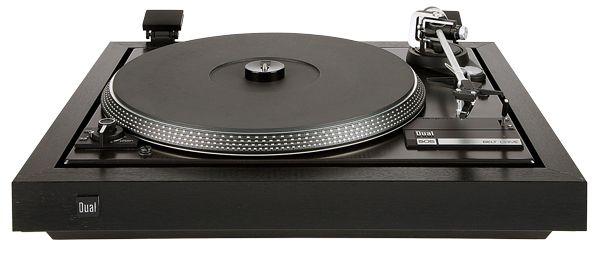Dual CS505 (Vintage)

If you were just taking your first steps into the world of hi-fi in the early 1980s you’d give serious consideration to the Dual CS505. Often partnered with a NAD 3020 amp by the canny hi-fi buyer on a budget, these two components started many listeners on a path that would bring countless hours of enjoyment.
In the 1960s and ’70s Dual occupied a similar place in the German market to BSR and Garrard in the UK, producing turntable units for music centres and combination units. Yet it retained audiophile credibility for the quality of its separate belt-drives, which sold well across Europe.
The CS505 first appeared in 1981 as a simplified version of the already established CS506. It met with instant success and became the best selling ‘proper’ turntable in the UK. The CS505-1 featured a lightweight cartridge to complement the deck’s famous low mass arm along with a revised counterweight. It also came with a restyled moulded plinth.
At £75 the CS505-1 was something of a bargain and perhaps the definitive version of the 505 series, but further changes were to come. The CS505-2 – the model tested here – returned to a boxy-looking plinth with a wooden perimeter which could be ordered in a choice of two veneered finishes or black. Changes were also made to the headshell so that it could now be unscrewed from the arm.
The platter was made from pressed aluminium sheet machined to make it attractive and accurate. A thick rubber mat effectively damped the ringing that would otherwise emanate from such a lightweight metallic structure and so it looked good and ran true.
The CS505 had more than a few features of interest. Firstly, the expanding ‘Vario Pulley’ allowed the speed of the deck to be fine-tuned. An interlock disabled the speed selector unless the platter was turning: this prevented the belt being damaged by an inexperienced user. And whenever the arm was returned to its rest the cueing lever was automatically set to a raised position, protecting the stylus.
A pleasing fluency
Ortofon 2M cartridge fitted, the Dual slotted nicely into our reference system. We began listening with the track ‘Dancing With Tears In My Eyes’ by Ultravox, from the Chrysalis album The Collection. As well as the strong and stable rhythm, the Dual revealed a fine vocal presence largely free of midrange muddle – not to mention a nice big ‘walk-in’ soundstage, which suggested it was working well with the cartridge.
Treble detail around the percussion was perhaps slightly veiled, but this is a minor criticism. The musical presentation was surprisingly good.
Despite the fact that the deck’s top plate is spring-mounted, we did find that careful positioning was essential otherwise acoustic feedback could affect the precision of the bass. The deck’s thin plastic bottom cover and delicate arm are both sensitive structures it seems.
To see how the CS505-2 would handle more serious musical fare we tried it with the beautiful Philips recording of Beethoven’s ‘Für Elise’. Here the Dual demonstrated a pleasing fluency around the individual piano notes. A slightly warmer tonality might have suited the piece better but each note was solid and steady – not always a given with belt-drives.
In absolute terms one could perhaps have wanted for more clarity around the textures that give each note its own distinctive character, but then we’re talking here of a deck that costs a fraction of the price of the best on the market. An impressively quiet background was another aspect of the CS505-2 which we came to appreciate. Rumble appeared to be well suppressed and hum (both mechanical and electrical) was subjectively absent.
Verdict
Dual’s evergreen budget turntable remains an excellent way to get into the gentle pastime of playing records. It remains a desirable asset, not just for those who enjoy collecting vintage components but for everyday listeners too. Well engineered, reliable and still in plentiful supply secondhand, it has lost none of its appeal.
Originally published in the 2013 Yearbook
























































